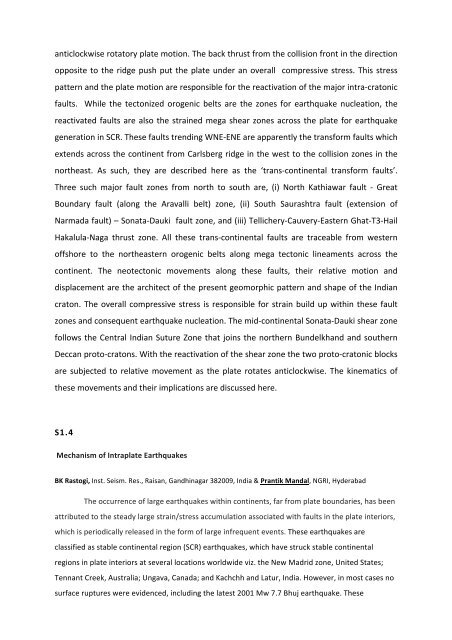indo–us workshop on “intraplate seismicity†- The CERI Blog
indo–us workshop on “intraplate seismicity†- The CERI Blog
indo–us workshop on “intraplate seismicity†- The CERI Blog
Create successful ePaper yourself
Turn your PDF publications into a flip-book with our unique Google optimized e-Paper software.
anticlockwise rotatory plate moti<strong>on</strong>. <strong>The</strong> back thrust from the collisi<strong>on</strong> fr<strong>on</strong>t in the directi<strong>on</strong><br />
opposite to the ridge push put the plate under an overall compressive stress. This stress<br />
pattern and the plate moti<strong>on</strong> are resp<strong>on</strong>sible for the reactivati<strong>on</strong> of the major intra-‐crat<strong>on</strong>ic<br />
faults. While the tect<strong>on</strong>ized orogenic belts are the z<strong>on</strong>es for earthquake nucleati<strong>on</strong>, the<br />
reactivated faults are also the strained mega shear z<strong>on</strong>es across the plate for earthquake<br />
generati<strong>on</strong> in SCR. <strong>The</strong>se faults trending WNE-‐ENE are apparently the transform faults which<br />
extends across the c<strong>on</strong>tinent from Carlsberg ridge in the west to the collisi<strong>on</strong> z<strong>on</strong>es in the<br />
northeast. As such, they are described here as the ‘trans-‐c<strong>on</strong>tinental transform faults’.<br />
Three such major fault z<strong>on</strong>es from north to south are, (i) North Kathiawar fault -‐ Great<br />
Boundary fault (al<strong>on</strong>g the Aravalli belt) z<strong>on</strong>e, (ii) South Saurashtra fault (extensi<strong>on</strong> of<br />
Narmada fault) – S<strong>on</strong>ata-‐Dauki fault z<strong>on</strong>e, and (iii) Tellichery-‐Cauvery-‐Eastern Ghat-‐T3-‐Hail<br />
Hakalula-‐Naga thrust z<strong>on</strong>e. All these trans-‐c<strong>on</strong>tinental faults are traceable from western<br />
offshore to the northeastern orogenic belts al<strong>on</strong>g mega tect<strong>on</strong>ic lineaments across the<br />
c<strong>on</strong>tinent. <strong>The</strong> neotect<strong>on</strong>ic movements al<strong>on</strong>g these faults, their relative moti<strong>on</strong> and<br />
displacement are the architect of the present geomorphic pattern and shape of the Indian<br />
crat<strong>on</strong>. <strong>The</strong> overall compressive stress is resp<strong>on</strong>sible for strain build up within these fault<br />
z<strong>on</strong>es and c<strong>on</strong>sequent earthquake nucleati<strong>on</strong>. <strong>The</strong> mid-‐c<strong>on</strong>tinental S<strong>on</strong>ata-‐Dauki shear z<strong>on</strong>e<br />
follows the Central Indian Suture Z<strong>on</strong>e that joins the northern Bundelkhand and southern<br />
Deccan proto-‐crat<strong>on</strong>s. With the reactivati<strong>on</strong> of the shear z<strong>on</strong>e the two proto-‐crat<strong>on</strong>ic blocks<br />
are subjected to relative movement as the plate rotates anticlockwise. <strong>The</strong> kinematics of<br />
these movements and their implicati<strong>on</strong>s are discussed here.<br />
S1.4<br />
Mechanism of Intraplate Earthquakes<br />
BK Rastogi, Inst. Seism. Res., Raisan, Gandhinagar 382009, India & Prantik Mandal, NGRI, Hyderabad<br />
<strong>The</strong> occurrence of large earthquakes within c<strong>on</strong>tinents, far from plate boundaries, has been<br />
attributed to the steady large strain/stress accumulati<strong>on</strong> associated with faults in the plate interiors,<br />
which is periodically released in the form of large infrequent events. <strong>The</strong>se earthquakes are<br />
classified as stable c<strong>on</strong>tinental regi<strong>on</strong> (SCR) earthquakes, which have struck stable c<strong>on</strong>tinental<br />
regi<strong>on</strong>s in plate interiors at several locati<strong>on</strong>s worldwide viz. the New Madrid z<strong>on</strong>e, United States;<br />
Tennant Creek, Australia; Ungava, Canada; and Kachchh and Latur, India. However, in most cases no<br />
surface ruptures were evidenced, including the latest 2001 Mw 7.7 Bhuj earthquake. <strong>The</strong>se


